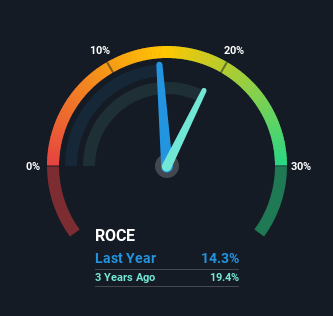Did you know there are some financial metrics that can provide clues of a potential multi-bagger? In a perfect world, we'd like to see a company investing more capital into its business and ideally the returns earned from that capital are also increasing. This shows us that it's a compounding machine, able to continually reinvest its earnings back into the business and generate higher returns. With that in mind, we've noticed some promising trends at Hind Rectifiers (NSE:HIRECT) so let's look a bit deeper.
Understanding Return On Capital Employed (ROCE)
Just to clarify if you're unsure, ROCE is a metric for evaluating how much pre-tax income (in percentage terms) a company earns on the capital invested in its business. The formula for this calculation on Hind Rectifiers is:
Return on Capital Employed = Earnings Before Interest and Tax (EBIT) ÷ (Total Assets - Current Liabilities)
0.14 = ₹180m ÷ (₹2.4b - ₹1.2b) (Based on the trailing twelve months to September 2021).
Therefore, Hind Rectifiers has an ROCE of 14%. That's a relatively normal return on capital, and it's around the 12% generated by the Electrical industry.
See our latest analysis for Hind Rectifiers

Historical performance is a great place to start when researching a stock so above you can see the gauge for Hind Rectifiers' ROCE against it's prior returns. If you're interested in investigating Hind Rectifiers' past further, check out this free graph of past earnings, revenue and cash flow.
So How Is Hind Rectifiers' ROCE Trending?
The trends we've noticed at Hind Rectifiers are quite reassuring. The numbers show that in the last five years, the returns generated on capital employed have grown considerably to 14%. The amount of capital employed has increased too, by 84%. The increasing returns on a growing amount of capital is common amongst multi-baggers and that's why we're impressed.
On a side note, Hind Rectifiers' current liabilities are still rather high at 48% of total assets. This effectively means that suppliers (or short-term creditors) are funding a large portion of the business, so just be aware that this can introduce some elements of risk. While it's not necessarily a bad thing, it can be beneficial if this ratio is lower.
What We Can Learn From Hind Rectifiers' ROCE
In summary, it's great to see that Hind Rectifiers can compound returns by consistently reinvesting capital at increasing rates of return, because these are some of the key ingredients of those highly sought after multi-baggers. And with the stock having performed exceptionally well over the last five years, these patterns are being accounted for by investors. Therefore, we think it would be worth your time to check if these trends are going to continue.
If you'd like to know more about Hind Rectifiers, we've spotted 4 warning signs, and 1 of them is concerning.
While Hind Rectifiers may not currently earn the highest returns, we've compiled a list of companies that currently earn more than 25% return on equity. Check out this free list here.
Valuation is complex, but we're here to simplify it.
Discover if Hind Rectifiers might be undervalued or overvalued with our detailed analysis, featuring fair value estimates, potential risks, dividends, insider trades, and its financial condition.
Access Free AnalysisHave feedback on this article? Concerned about the content? Get in touch with us directly. Alternatively, email editorial-team (at) simplywallst.com.
This article by Simply Wall St is general in nature. We provide commentary based on historical data and analyst forecasts only using an unbiased methodology and our articles are not intended to be financial advice. It does not constitute a recommendation to buy or sell any stock, and does not take account of your objectives, or your financial situation. We aim to bring you long-term focused analysis driven by fundamental data. Note that our analysis may not factor in the latest price-sensitive company announcements or qualitative material. Simply Wall St has no position in any stocks mentioned.
About NSEI:HIRECT
Hind Rectifiers
Designs, develops, manufactures, and markets power semiconductors, power electronic equipment, and railway transportation equipment in India and internationally.
Solid track record with adequate balance sheet.
Market Insights
Community Narratives



